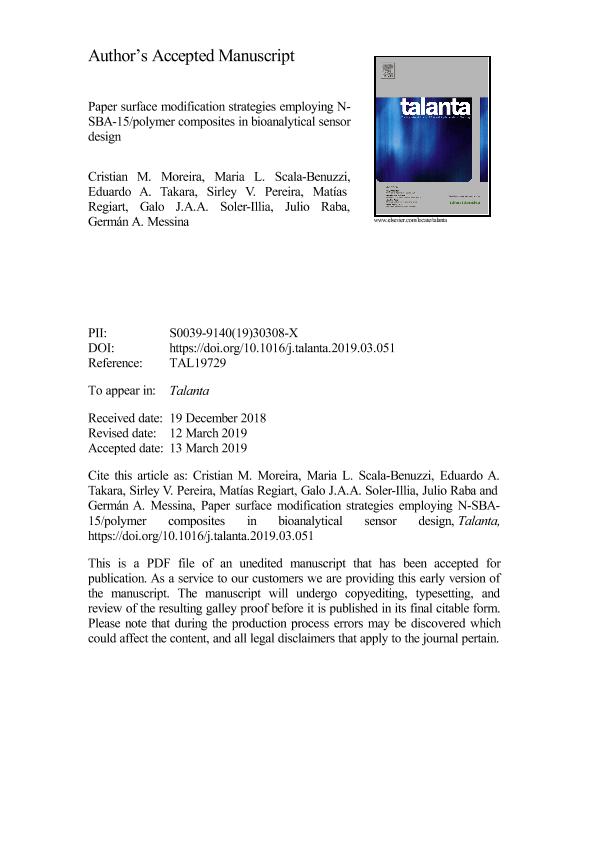Artículo
Paper surface modification strategies employing N-SBA-15/polymer composites in bioanalytical sensor design
Moreira, Cristian Matias ; Scala Benuzzi, María Luz
; Scala Benuzzi, María Luz ; Takara, Eduardo Andres
; Takara, Eduardo Andres ; Pereira, Sirley Vanesa
; Pereira, Sirley Vanesa ; Regiart, Daniel Matias Gaston
; Regiart, Daniel Matias Gaston ; Soler Illia, Galo Juan de Avila Arturo
; Soler Illia, Galo Juan de Avila Arturo ; Raba, Julio
; Raba, Julio ; Messina, Germán Alejandro
; Messina, Germán Alejandro
 ; Scala Benuzzi, María Luz
; Scala Benuzzi, María Luz ; Takara, Eduardo Andres
; Takara, Eduardo Andres ; Pereira, Sirley Vanesa
; Pereira, Sirley Vanesa ; Regiart, Daniel Matias Gaston
; Regiart, Daniel Matias Gaston ; Soler Illia, Galo Juan de Avila Arturo
; Soler Illia, Galo Juan de Avila Arturo ; Raba, Julio
; Raba, Julio ; Messina, Germán Alejandro
; Messina, Germán Alejandro
Fecha de publicación:
08/2019
Editorial:
Elsevier Science
Revista:
Talanta
ISSN:
0039-9140
Idioma:
Inglés
Tipo de recurso:
Artículo publicado
Clasificación temática:
Resumen
In this work, different paper surface modification strategies were compared to obtain an amine functionalized SBA-15 (N-SBA-15) composite for paper-based device development. The synthesized N-SBA-15 was characterized by N 2 adsorption-desorption isotherm, and infrared spectroscopy (FTIR), and it was incorporated to different polymer matrices (κ-carrageenan (CA), polyvinyl alcohol (PVA) and polyethylenimine (PEI)) for the development of the composite modified paper-based device. The retention, interactions, and morphology of the obtained composites were investigated by absorbance measurement, FTIR and scanning electron microscopy (SEM), respectively. To demonstrate the applicability of the modified paper-based device, ascorbic acid (AA) quantification was carried out. Horseradish peroxidase (HRP) was immobilized onto the modified paper surface. HRP in the presence of H 2 O 2 catalyzes the oxidation of 10-acetyl-3,7-dyhidroxyphenoxazine (ADHP) to highly fluorescent resorufin, which was measured by LIF detector. Thus, when AA was added to the solution, it decreases the relative fluorescence signal proportionally to the AA concentration. The linear range from 50 nmol L −1 to 1500 nmol L −1 and a detection limit of 15 nmol L −1 were obtained for AA quantitation. The obtained results allowed us to conclude that N-SBA-15/PEI composite could be considered an excellent choice for the paper-based device modification procedure due to its inherent simplicity, low cost, and sensitivity.
Palabras clave:
ASCORBIC ACID, N-SBA-15
,
FLUORESCENCE
,
PAPER-BASED DEVICE
,
POLYETHYLENIMINE
Archivos asociados
Licencia
Identificadores
Colecciones
Articulos(INQUISAL)
Articulos de INST. DE QUIMICA DE SAN LUIS
Articulos de INST. DE QUIMICA DE SAN LUIS
Articulos(SEDE CENTRAL)
Articulos de SEDE CENTRAL
Articulos de SEDE CENTRAL
Citación
Moreira, Cristian Matias; Scala Benuzzi, María Luz; Takara, Eduardo Andres; Pereira, Sirley Vanesa; Regiart, Daniel Matias Gaston; et al.; Paper surface modification strategies employing N-SBA-15/polymer composites in bioanalytical sensor design; Elsevier Science; Talanta; 200; 8-2019; 186-192
Compartir
Altmétricas



